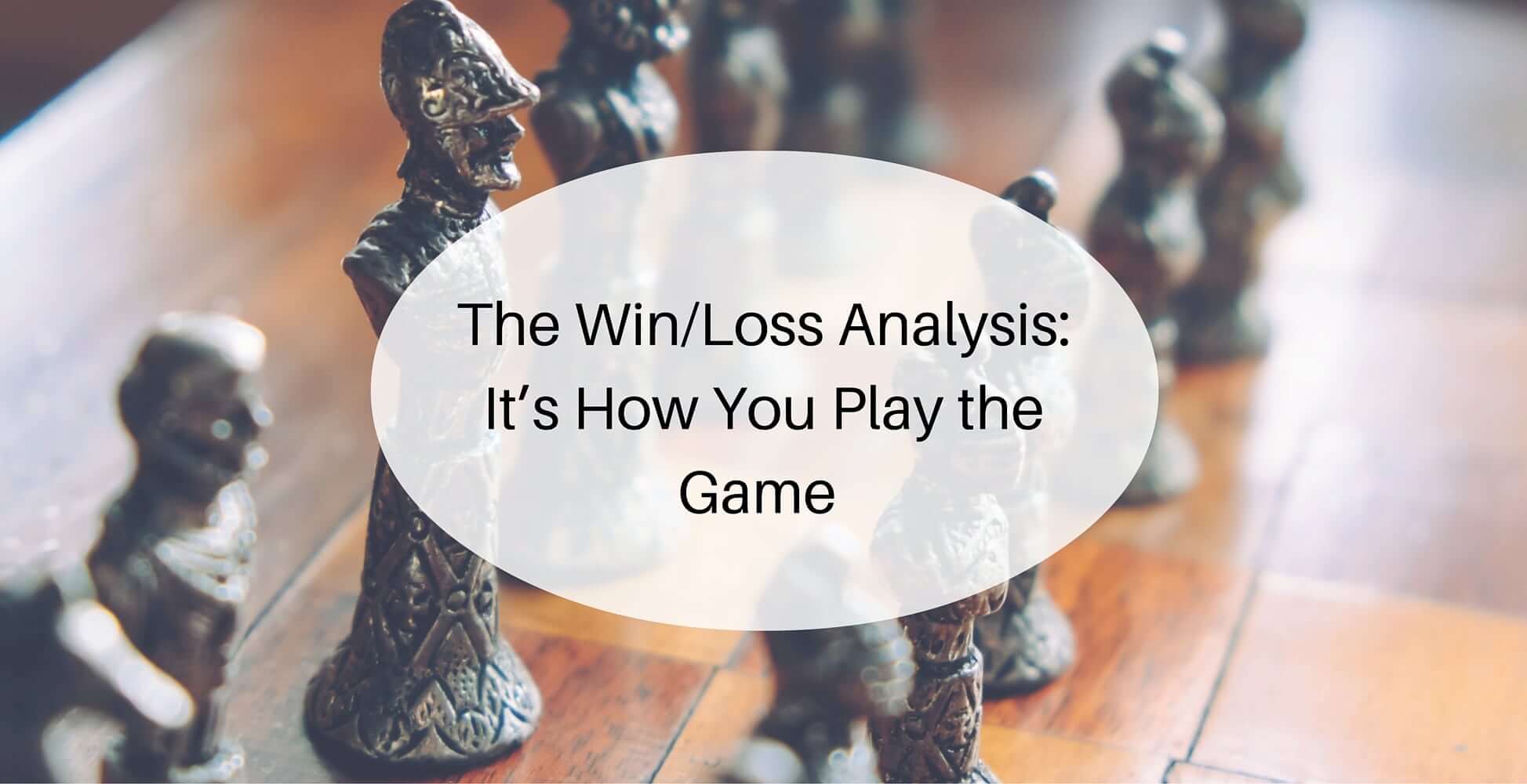At a recent meeting, several marketers spoke about the deal flow challenges facing their companies. They were frustrated with the stall out at various stages of the buying process and the number of lost deals. So, I asked, “What kind of analysis do you do to understand your opportunity pipeline movement? For example, do you do win/loss analysis across the customer buying process to understand why opportunities do or don’t convert at each stage, why some opportunities stall vs those that move, and of course, why you won or lost the deal?” Each of the marketers said in so many words, “we don’t do this analysis on a regular basis and when we do, we leave the research and analysis to our sales team.”
“It’s not whether you win or lose, it’s how you play the game.” The first part of this Grantland Rice quote does not apply in the business world where wins and losses mean everything. But understanding how you played the game is applicable. So it’s surprising that many companies fail to implement an effective win/loss program so they can do better next time. At VisionEdge Marketing, we have found that companies with an institutionalized, timely, thorough and unbiased program that incorporates a customer decision maker-derived methodology, as opposed to a sales-derived one, gain the insights needed to help them continuously improve their win/loss ratio, and ultimately increase revenue and competitive advantage.
Why Win Loss Analysis Should Be Institutionalized
While there is merit in having your sales team conduct a brief on why deals are won or lost, this analysis alone is incomplete and biased. When done properly, win/loss analyses examine all points across the buying process (not just the sales team touch points), to provide clarity and insights into customers’ perceptions of your product, and examine expectations created by your company messaging. Institutionalizing win/loss analysis surfaces new requirements for product development, provides feedback about messaging to marketing, and may help uncover new sales strategies and initiatives. For win/loss analysis to be beneficial, it needs to be done in a timely fashion with accuracy and objectivity.
A properly conducted win/loss analysis helps answer these questions:
-
Why do customers select your products and/or services?
-
What are the most important criteria for selecting products/services in your category?
-
Why did your prospects initially select your competitors’ products and/or services over yours?
-
Why are your prospects considering, or no longer considering, your products/services?
-
What would your company have needed to make it to the short list?
-
How do your competitors position themselves?
-
How do your customers and prospects perceive your sales and marketing efforts?
-
How do your customers and prospects perceive competitors and their products/services?
-
How effective is your marketing and sales team in presenting your company, your value proposition, and your products and/or services?
Many companies think they know the answers to these questions based on anecdotal information from their sales organization. Perhaps you’ve even heard: “We could have won this deal if we had X feature in the product.” Maybe adding the feature is the right thing to do, but maybe it isn’t. Using anecdotal information creates a reactive rather than a proactive process. The implications of win/loss analysis extend beyond your sales team and enterprise. It should provide a complete picture into competitor products, services, price, sales channels, and marketing, in addition to the prospect/customer evaluation process.
How to Obtain a Thorough and Unbiased Analysis
Relying on an outside organization to conduct win/loss analysis is a good idea because it allows for more candid and detailed responses. Companies often have sales or marketing people perform the win/loss analysis and this can result in skewed data. The reasons offered by customers and prospects for winning or losing are typically surface-level, such as price, feature set or lack of budget. It takes an experienced interviewer to glean the underlying reasons, provide proper analysis to identify the strengths and weaknesses of your competition (beyond their product), and then identify patterns that you can use for setting strategic and tactical direction on sales, marketing and product development hiring, training and management. While using an outside party may appear more expensive, the benefits outweigh the cost. Prospects and customers tend to be more willing and candid with a third party, and can really protect the individual’s confidentiality. Third parties don’t have a vested interest in a particular answer; their goal is to seek the truth.
Defining Win/Loss Analysis
Win/loss analysis is not a customer satisfaction study. It is a process for differentiating why one sales effort wins while others fall short of the mark. The purpose of win/loss analysis is to learn the pros, cons, likes, dislikes, competitive advantages and disadvantages from the specific people responsible for the purchase decision.
Upon completing the win/loss analysis you will actually have a metric; a win/loss ratio. This ratio is based on the total number of deals won compared to the total number of deals lost. For example, if there were 100 opportunities in the final consideration phases in your pipeline, 60 won and 40 lost, your win/loss ratio would then be 3:2. The ratio doesn’t account for revenue; it simply measures your win/loss track record. Over time it will be important to understand whether deals being won are smaller than deals being lost, or vice versa. The win/loss ratio can serve as powerful indicating metric. A declining ratio serves as a huge red flag that should create internal urgency to better understand and quickly address the causes behind the trend.
An improving ratio signals the need to understand what is or isn’t working in order to establish a process that can be duplicated by the entire team. As you delve deeper into the win/loss analysis, you’ll be able to use the data to identify when a competitor is outflanking you or establishing requirements in an account before you’re even a part of the deal.
Topics to Include In the Discussion:
To learn why you are winning or losing in order to understand what are doing right or wrong, you’ll want to be sure your analysis includes the following topics:
-
How they found out about your company and the product category?
-
What problem were they trying to solve with your product or service?
-
Who they received advice from during the buying process?
-
Whether there were any breakdowns during the sales cycle, if so what were they?
-
What is the competition doing right, and what are they doing to win?
-
What do you need to do in terms of technology, service, selling, product, etc., to win have won the deal?
When and How to Conduct the Analysis:
Now we’re talking about implementing a win/loss program, something that is done on a regular and frequent basis as opposed to once in awhile. A win/loss program generally involves performing monthly research to understand why opportunities are, or are not, moving and why deals are won or lost.
Understanding what’s accelerating or impeding deal flow enables real-time adjustments to your sales and marketing processes. Engaging a third party to conduct in-depth interviews with customers you’ve won or lost will help you understand and measure what occurred during the buying process.
Successful analysis rests on being able to capture unbiased, in-depth information with all the key decision makers and influencers. Conducting the analysis in person is ideal, but often impractical. Phone interviews are the most common approach and much better than a written survey. Written surveys sometimes supplement telephone interviews when you require more detailed help in ranking customer wants and needs.
Experts in this area will help you with all three phases of the process:
-
Pre-interview: you and your experts collaboratively develop questions and participant list
-
Interview
-
Post-interview – participant follow up, data analysis regarding patterns, perceptions, and processes, opportunity and competitive assessment, and of course recommendations.
By adopting win/loss as an ongoing process you will have data in real-time that sales, marketing, and product development can use to act on, and adjust more quickly, to offset problems and exploit advantages. Win/loss analysis isn’t about determining who is “at fault” for a lost deal; it is about gaining insights to improve results and bolster revenue. The value of win/loss analysis and data is in its ability to affect sales training, define marketing strategies, and prioritize product development efforts all aimed at one thing – improving your organization’s competitive advantage.
Learn more about Pipeline Opportunity Movement with this free white paper, Don’t Waste Your Bullets: Customer Engagement To Accelerate Revenue And Improve Alignment.


